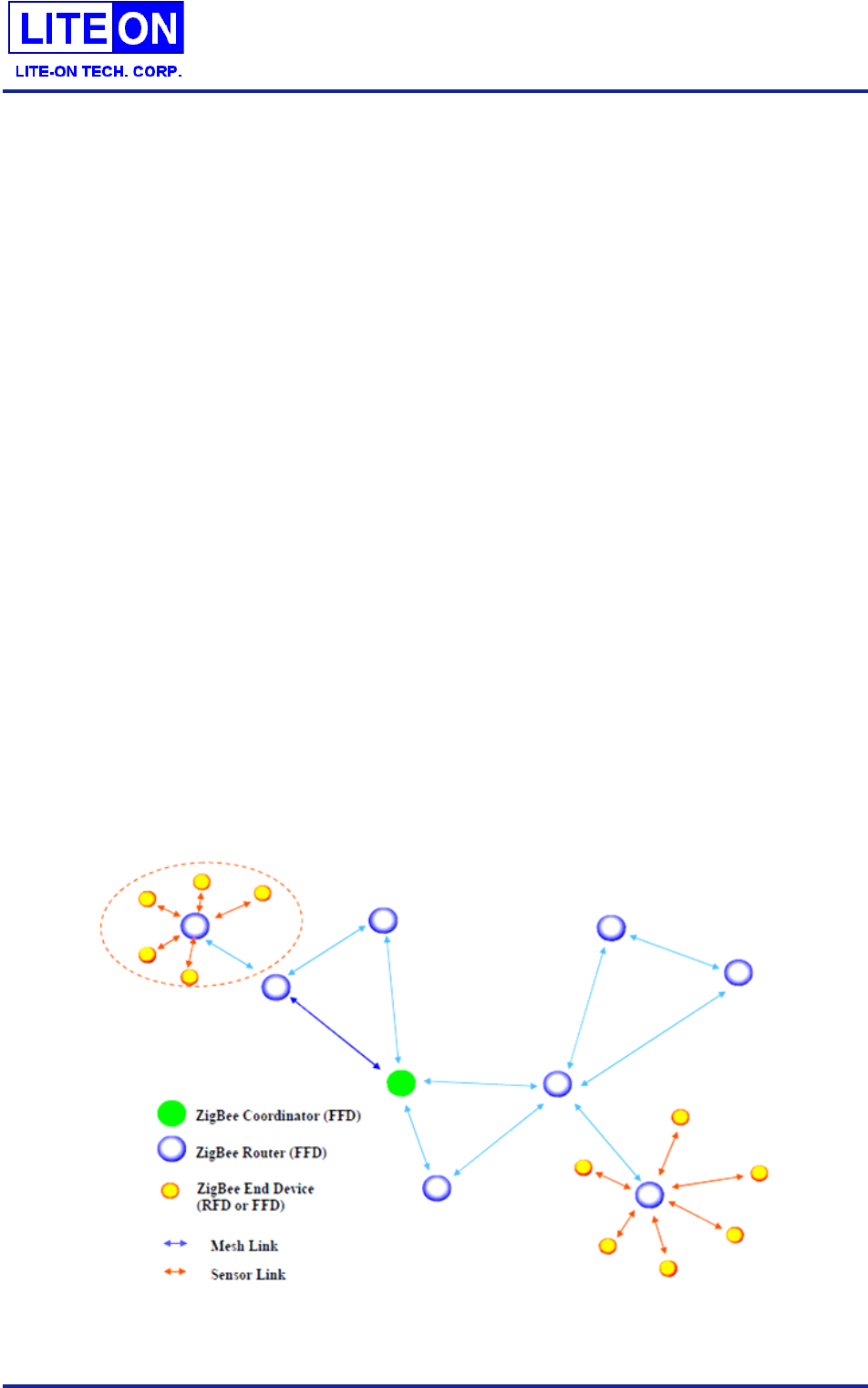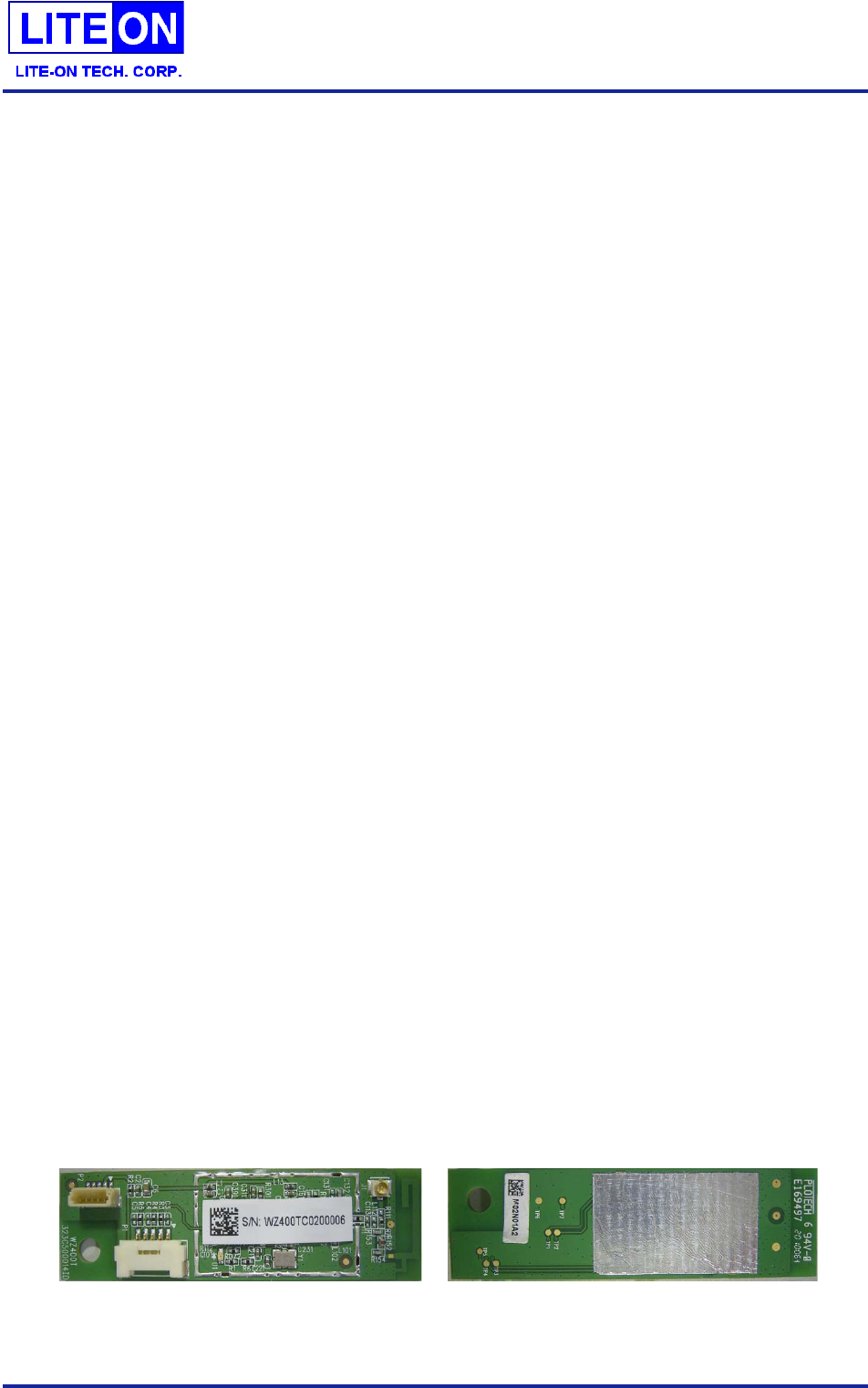LITE ON TECHNOLOGY WZ400T 2.4GHz ZigBee Module User Manual
LITE-ON Technology Corp. 2.4GHz ZigBee Module
user manual

By Tracy Chang 2010-03-04 Page 1/6
TI ZigBee Module WZ400T
User’s Manual
INTRODUCTION OF ZIGBEE … 2
PRODUCT FEATURES … 3
USER GUIDE … 4
FEDERAL COMMUNICATION COMMISSION
INTERFERENCE STATEMENT … 4
EUROPE – EU DECLARATION OF CONFORMITY … 5

By Tracy Chang 2010-03-04 Page 2/6
Introduction of ZigBee
ZigBee is a standard for a suite of high level communication protocols using
small, low-power digital radios based on the IEEE 802.15.4-2003 standard for
wireless personal area networks (WPANs). The technology defined by the
ZigBee specification is intended to be simpler and less expensive than other
WPANs, such as Bluetooth. ZigBee is targeted at radio-frequency (RF)
applications that require a low data rate, long battery life, and secure
networking.
ZigBee protocols are intended for use in embedded applications requiring low
data rates and low power consumption. ZigBee's current focus is to define a
general-purpose, inexpensive, self-organizing mesh network that can be used
for industrial control, embedded sensing, medical data collection, smoke and
intruder warning, building automation, home automation, etc.
ZigBee is a mesh network architecture (see Picture 1). Its network layer
supports three types of topologies: both star and tree typical networks and
generic mesh networks. As one of its defining features, ZigBee provides
facilities for carrying out secure communications, protecting establishment and
transport of cryptographic keys, cyphering frames and controlling devices. It
builds on the basic security framework defined in IEEE 802.15.4.
Picture 1. ZigBee network model

By Tracy Chang 2010-03-04 Page 3/6
Product Features
The WZ400T is using TI CC2530+CC2591 solution for IEEE 802.15.4, ZigBee
and RF4CE applications. It enables robust network nodes to work for ZigBee
function. The CC2530 combines the excellent performance of a leading RF
transceiver with an industry-standard enhanced 8051 MCU, in-system
programmable flash memory, 8-KB RAM, and many other powerful features.
The module has various operating modes, making it highly suited for systems
where ultralow power consumption is required. Short transition times between
operating modes further ensure low energy consumption.
RF function:
2.4GHz IEEE802.15.4 Compliant RF Transceiver
Excellent Receiver Sensitivity and Robustness to Interference
Programmable output power up to 17dBm for combination
Only a Single Crystal Needed for Mesh Network Systems
Embedded Microcontroller (8051) in main-chip:
High-Performance and Low Power 8051 Core with Code Pre-fetch
256KB In-System-Programmable Flash
8KB RAM with Retention in All Power Modes
Low power consumption CSMA/CA Hardware Support
Accurate Digital RSSI/LQI Support AES Security Coprocessor
Tiny Form Factor RoHS Compliant
Mechanical:
Dimensions (L x W x H): 60mm (+/-0.1mm) x 18 mm (+/-0.1mm) x 1.6mm
(+/-0.1mm); Weight: 5g.

By Tracy Chang 2010-03-04 Page 4/6
User Guide
The driver has been installed in WZ400T, user does not need to do any
installation steps. Just connect devices, and then it works.
Federal Communication Commission
Interference Statement
This equipment has been tested and found to comply with the limits for a Class
B digital device, pursuant to Part 15 of the FCC Rules. These limits are
designed to provide reasonable protection against harmful interference in a
residential installation. This equipment generates, uses and can radiate radio
frequency energy and, if not installed and used in accordance with the
instructions, may cause harmful interference to radio communications.
However, there is no guarantee that interference will not occur in a particular
installation. If this equipment does cause harmful interference to radio or
television reception, which can be determined by turning the equipment off and
on, the user is encouraged to try to correct the interference by one of the
following measures:
- Reorient or relocate the receiving antenna.
- Increase the separation between the equipment and receiver.
- Connect the equipment into an outlet on a circuit different from that
to which the receiver is connected.
- Consult the dealer or an experienced radio/TV technician for help.
FCC Caution: Any changes or modifications not expressly approved by the
party responsible for compliance could void the user's authority to operate this
equipment.
This device complies with Part 15 of the FCC Rules. Operation is subject to the
following two conditions: (1) This device may not cause harmful interference,
and (2) this device must accept any interference received, including
interference that may cause undesired operation.
The antenna(s) used for this transmitter must not be co-located or operating in
conjunction with any other antenna or transmitter.

By Tracy Chang 2010-03-04 Page 5/6
IMPORTANT NOTE:
FCC Radiation Exposure Statement:
This equipment complies with FCC radiation exposure limits set forth for an
uncontrolled environment. This equipment should be installed and operated
with minimum distance 20cm between the radiator & your body.
This device is intended only for OEM integrators under the following
conditions:
- The antenna must be installed such that 20 cm is maintained
between the antenna and users.
As long as condition above is met, further transmitter test will not be required.
However, the OEM integrator is still responsible for testing their end-product
for any additional compliance requirements required with this module installed
(for example, digital device emissions, PC peripheral requirements, etc.).
IMPORTANT NOTE: In the event that these conditions can not be met (for
example certain laptop configurations or co-location with another transmitter),
then the FCC authorization is no longer considered valid and the FCC ID can
not be used on the final product. In these circumstances, the OEM integrator
will be responsible for re-evaluating the end product (including the transmitter)
and obtaining a separate FCC authorization.
Europe – EU Declaration of Conformity
This device complies with the essential requirements of the R&TTE Directive
1999/5/EC. The following test methods have been applied in order to prove
presumption of conformity with the essential requirements of the R&TTE
Directive 1999/5/EC:
- EN60950-1:2001 A11:2004
Safety of Information Technology Equipment
- EN50371 : (2002-03)
Generic standard to demonstrate the compliance of low power electronic
and electrical apparatus with the basic restrictions related to human
exposure to electromagnetic fields (10 MHz - 300 GHz) -- General public
- EN 300 328 V1.6.1 (2004-11)

By Tracy Chang 2010-03-04 Page 6/6
Electromagnetic compatibility and Radio spectrum Matters (ERM);
Wideband transmission systems; Data transmission equipment operating
in the 2,4 GHz ISM band and using wide band modulation techniques;
Harmonized EN covering essential requirements under article 3.2 of the
R&TTE Directive
- EN 301 489-1 V1.6.1: (2005-09)
Electromagnetic compatibility and Radio Spectrum Matters (ERM);
ElectroMagnetic Compatibility (EMC) standard for radio equipment and
services; Part 1: Common technical requirements
- EN 301 489-17 V1.2.1 (2002-08)
Electromagnetic compatibility and Radio spectrum Matters (ERM);
ElectroMagnetic Compatibility (EMC) standard for radio equipment and
services; Part 17: Specific conditions for 2,4 GHz wideband transmission
systems and 5 GHz high performance RLAN equipment
This device is a 2.4 GHz wideband transmission system (transceiver),
intended for use in all EU member states and EFTA countries, except in
France and Italy where restrictive use applies.
In Italy the end-user should apply for a license at the national spectrum
authorities in order to obtain authorization to use the device for setting up
outdoor radio links and/or for supplying public access to telecommunications
and/or network services.
This device may not be used for setting up outdoor radio links in France and in
some areas the RF output power may be limited to 10 mW EIRP in the
frequency range of 2454 – 2483.5 MHz. For detailed information the end-user
should contact the national spectrum authority in France.